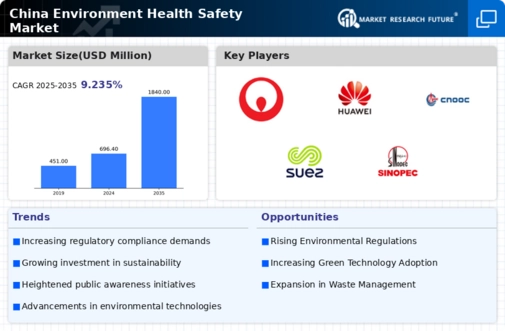Regulatory Compliance Pressure
The increasing pressure for regulatory compliance is a pivotal driver in the environment health-safety market. In China, the government has implemented stringent regulations aimed at reducing pollution and enhancing workplace safety. This regulatory landscape compels industries to invest in compliance measures, which in turn drives demand for environment health-safety solutions. For instance, the Ministry of Ecology and Environment has set ambitious targets for air quality improvement, necessitating investments in monitoring and control technologies. As a result, companies are likely to allocate substantial budgets towards ensuring adherence to these regulations, thereby propelling the growth of the environment health-safety market.
Industrial Growth and Urbanization
China's rapid industrial growth and urbanization are significant factors influencing the environment health-safety market. As urban areas expand and industries proliferate, the potential for environmental hazards increases. This necessitates the implementation of robust health and safety measures to protect workers and the public. The construction sector alone has seen investments exceeding $1 trillion in recent years, highlighting the need for effective safety protocols. Consequently, the environment health-safety market is expected to experience heightened demand for innovative solutions that address the challenges posed by urbanization and industrial activities.
Public Health Concerns and Awareness
Growing public health concerns are driving awareness and demand for environment health-safety solutions in China. The population is becoming increasingly cognizant of the health implications associated with environmental hazards, such as air and water pollution. This heightened awareness is prompting both consumers and businesses to prioritize safety measures. For instance, surveys indicate that over 70% of urban residents express concern about air quality, leading to increased demand for air monitoring systems and pollution control technologies. As public health remains a priority, the environment health-safety market is poised for growth as stakeholders seek to mitigate risks.
Corporate Social Responsibility Initiatives
Corporate social responsibility (CSR) initiatives are emerging as a key driver in the environment health-safety market. In China, companies are increasingly recognizing the importance of sustainable practices and their impact on brand reputation. As a result, many organizations are investing in environment health-safety measures to demonstrate their commitment to social and environmental stewardship. This trend is particularly evident in sectors such as manufacturing and energy, where companies are allocating significant resources to improve safety standards and reduce environmental footprints. The alignment of CSR with business strategies is likely to bolster the environment health-safety market as firms strive to meet stakeholder expectations.
Technological Integration in Safety Practices
The integration of advanced technologies into safety practices is transforming the environment health-safety market. In China, industries are increasingly adopting IoT, AI, and big data analytics to enhance safety protocols and monitor environmental conditions. For example, smart sensors are being deployed to detect hazardous substances in real-time, allowing for immediate response measures. This technological shift not only improves compliance with safety regulations but also reduces operational risks. As companies recognize the value of these technologies, investment in the environment health-safety market is likely to surge, fostering innovation and efficiency.
















Leave a Comment